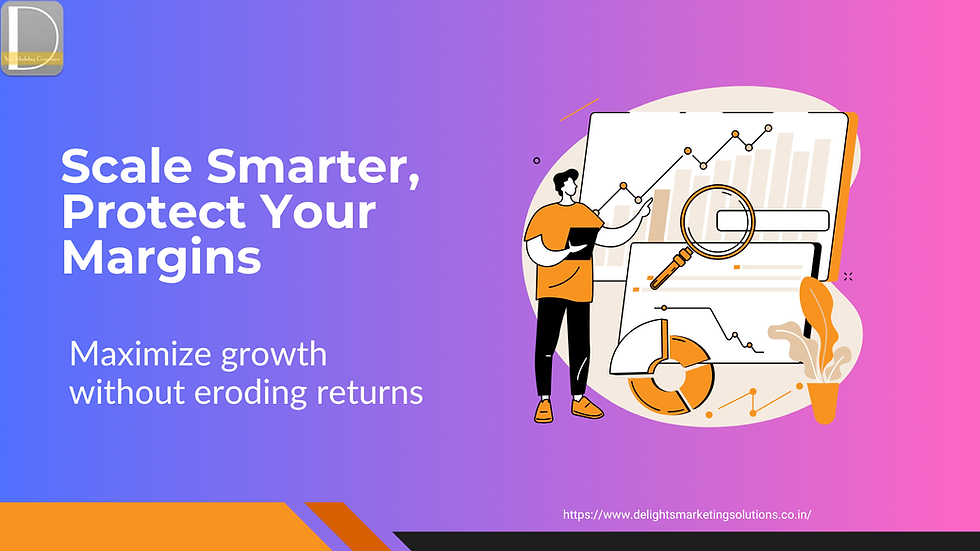Scaling Paid Campaigns Without Sacrificing Profit: A Practical Guide for High-Growth Brands
- Arijit Dutta
- Jul 1
- 4 min read

Executive Summary
Paid advertising remains a proven growth lever for high-growth brands. However, the challenge is to scale these campaigns without eroding profitability. Rapid increases in advertising budgets can lead to diminishing returns, ad fatigue, and wasted resources. This whitepaper provides a practical, strategic roadmap for scaling paid campaigns sustainably, protecting profitability while maximizing growth.
Introduction
As brands scale, paid media often becomes the dominant channel to drive conversions and revenue. In fact, global search ad spending is projected to reach $351.5 billion in 2025, underscoring the central role of paid campaigns in modern growth strategies. Yet simply spending more does not guarantee success. Rising cost-per-clicks (CPCs), which increased across 86% of industries in 2024, and ad fatigue are eroding returns for many advertisers.
Many businesses struggle to maintain profitable customer acquisition as they grow their ad budgets. They face reduced efficiency, greater auction competition, and diminishing returns. For example, while 75% of PPC professionals use AI to write ads, only 52% report satisfaction with campaign creation outcomes, highlighting the gap between automation and strategic execution.
Scaling paid campaigns is not just a media buying problem. It is a holistic exercise that involves creative strategy, data operations, funnel design, and customer experience. To scale profitably, brands must combine rigorous performance measurement with continuous creative testing, audience segmentation, and process automation.
This paper provides a framework to help high-growth businesses scale paid advertising in a disciplined, profitable way.
Understanding the True Cost of Scaling
Scaling campaigns reveals the cracks in your cost structure. It is crucial to build a clear view of all costs tied to acquisition, not just media spend. Brands should include production costs, creative development, landing page infrastructure, tracking systems, and post-click nurturing expenses.
The most successful scaling efforts rely on a precise understanding of blended customer acquisition costs, the lifetime value of each customer, and the timeline to recover those costs. When these metrics are mapped clearly, brands can forecast how budget increases will impact margins.
Preparing Your Foundation for Scale
Before increasing budgets, validate the strength of your campaign’s fundamentals. Scaling poor-performing campaigns only multiplies their weaknesses. Assess whether current campaigns are converting at healthy rates, whether targeting aligns with audience intent, and whether the landing experience matches the ad promise.
Conversion tracking and attribution must also be precise. Without accurate measurement, scaling is simply gambling with larger sums. A strong measurement foundation is essential to know where to invest, where to pause, and what to optimize.
Scaling with Discipline
Incremental growth protects budgets and supports sustainable outcomes. Instead of large, abrupt jumps in ad spend, a structured approach to scaling allows teams to adapt.
Gradually increasing budgets while monitoring metrics such as cost per acquisition, return on ad spend, and customer lifetime value helps maintain stability. Performance dips should be addressed quickly, rather than hoping higher budgets alone will resolve them.
It is also vital to build in creative refresh cycles. As reach grows, ads tend to fatigue audiences. Consistent creative testing prevents performance from eroding and ensures messaging stays relevant.
Diversifying Without Losing Focus
Scaling often creates the temptation to expand across too many channels at once. While channel diversification reduces risk, spreading budgets thin can damage performance if executed without a clear strategy.
Brands should expand to new platforms one at a time, with tailored creative, audience research, and channel-specific measurement. A measured, sequential rollout preserves learnings and keeps budgets under control while exploring new growth opportunities.
Ensuring Funnel Alignment
Even with a strong paid campaign, the downstream funnel must be capable of handling new traffic. Scaling only succeeds if landing pages, onboarding flows, and follow-up processes can absorb the increased demand.
High-growth brands should review their website’s conversion rates, customer nurturing processes, and sales team readiness. If gaps exist, address them before ramping up paid campaigns. Otherwise, scaling efforts risk becoming a leaky bucket with lost opportunities.
Leveraging Automation and Data
Automation supports scale by reducing errors and improving speed of response. Budget rules, audience triggers, and creative testing systems should be automated where possible.
At the same time, data visibility must remain high. Scaling requires constant measurement and adaptation. Human oversight is still needed to adjust for unexpected shifts in audience behavior or platform changes.
Building a Culture of Adaptation
Perhaps the most important mindset for scaling profitably is a culture of continuous learning. Scaling is not a one-time project but an ongoing discipline. Teams must measure, experiment, and optimize repeatedly.
Investing in knowledge-sharing across marketing, creative, sales, and product teams ensures campaigns remain connected to broader business objectives. When these functions work in silos, scaling initiatives often fail.
In Closing
Scaling paid campaigns is a core growth driver for modern brands, but doing so without sacrificing profit demands rigor. From establishing a strong measurement foundation to pacing growth and aligning funnel operations, the approach must be holistic and sustainable.
At Delights Marketing Solutions, we help high-growth brands build paid advertising strategies that scale profitably, integrate full-funnel performance, and protect long-term margins.
If you want to talk about making your paid campaigns work harder and grow with confidence, get in touch today.




Comments